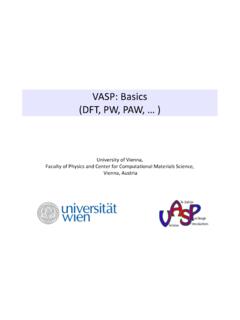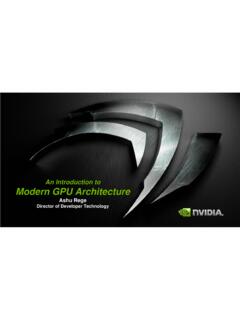Transcription of VASP Tutorial: Atoms, molecules and bulk systems - NERSC
1 VASP Tutorial: Atoms, molecules , and bulk systems University of Vienna, Faculty of Physics and Center for Computational Materials Science, Vienna, Austria Setting up a VASP calculation VASP requires 4 input files to run a calculation: INCAR. POSCAR. KPOINTS. POTCAR. I: The INCAR file The INCAR file contains the input parameters that steer the calculation: The default values set by VASP itself are a clever choice for most standard calculations These standard settings may be modified to specify: What kind of calculation you want to do: SCF calculation, DOS, dielectric properties, . Basic inputs concering the required precision, the requested level of convergence.
2 For a list of all INCAR-tags have a look at: The VASP manual: Index: The VASP wiki: INCAR-tags: :INCAR. II: The POSCAR file In the POSCAR file you specify the structure (Bravais lattice and basis): fcc: Ni Header (comment). Overall scaling constant Bravais matrix Ni Name(s) of atomic type(s). 1 Number of atoms (of each type). Selective Dynamics (optional: selective dynamics). Cartesian Cartesian or Direct coordinates 0 0 0 (T T T) positions of the atoms III: The KPOINTS file In the KPOINTS file you specify the points VASP will use to sample the first Brillouin zone in reciprocal space Automatic mesh Header (comment). 0 Nk=0: automatic mesh generation G (M) -centered (G) mesh or Monkhorst-Pack (M) grid 4 4 4 # of subdivisions along.
3 0. 0. 0. Optionally shift the mesh ( ). IV: The POTCAR file The POTCAR file has to contain the PAW datasets for all atomic types you have specified in your POSCAR file: VASP comes with a library of PAW datasets, (one or more) for most elements of the periodic table: Each individual PAW data set starts with a descriptive section, specifying amongst other things: Parameters that were required to generate the dataset: Number of valence electrons Atomic mass Default energy cutoffs When your unit cell contains more than one type of atom you have to concatenate the corresponding PAW datasets in the same order as you have specified the different atomic types in your POSCAR file.
4 You should not mix PAW datasets generated with different exchange-correlation functionals. OUTPUT files OUTCAR. detailed output of a VASP run, including: a summary of the input parameters information about the individual electronic steps: total energy, Kohn-Sham eigenvalues, Fermi-energy. stress tensors forces in the atoms local charges, magnetic moments dielectric properties .. and a great many things more .. The amount of output written onto OUTCAR can be chosen by means of the NWRITE-tag in the INCAR file. OSZICAR & stdout give a short summary of the self-consistency-cycle chosen SCF algorithm convergence of energy and charge density free energies, total magnetic moment of the cell OUTPUT files CONTCAR & XDATCAR.
5 CONTCAR: updated geometry data at the end of a run lattice parameter Bravais matrix ionic positions velocities the format of the CONTCAR is the same as for POSCAR: It can be directly be used for a continuation run (copy CONTCAR to POSCAR). XDATCAR: updated ionic positions of each ionic step DOSCAR, CHGCAR & WAVECAR. DOSCAR: total DOS and integrated DOS, (local partial DOS). CHGCAR: the charge density WAVECAR: plane wave coefficients of the orbitals. Can be used to restart from a previous run Atoms and molecules Examples: O atom O2 dimer CO. H2O. Tasks: Single point total energy Relaxation Vibrational frequencies MD. The oxygen atom (ex.: O atom). The POSCAR file specifies the Bravais lattice (lattice vectors) and basis (atomic positions).
6 In this case, a single atom in a box: O atom in a box Header (comment). Overall scaling constant lattice vector a(1). lattice vector a(2). lattice vector a(3). 1 Number of atoms cart Positions in cartesian coordinates 0 0 0 positions of atom 1. The INCAR file steers the calculation SYTEM = O atom in a box Name of the calculation ISMEAR = 0 Selects Gaussian smearing The oxygen atom (ex.: O atom). The KPOINTS file determines which Bloch wave vectors are used to sample the first Brillouin zone. For atoms or molecules only a single k-point is used: = 0 (the -point). Were more/other k-points to be used, only the interaction between the periodically repeated images of the atom or molecule, that we'd like to be zero, are described moreaccurately.
7 The KPOINTS file: Gamma-point only Header (comment). 0 Nk=0: automatic mesh generation Monkhorst-Pack Monkhorst-Pack grid 1 1 1 # of subdivisions along . 0. 0. 0. Optionally shift the mesh ( ). The oxygen atom (ex.: O atom). Running VASP should yield the following on stdout (and much the same on OSZICAR): running on 8 total cores distrk: each k-point on 8 cores, 1 groups distr: one band on 1 cores, 8 groups using from now: INCAR. 05 Feb16 (build Aug 22 2016 16:46:23) complex POSCAR found : 1 types and 1 ions scaLAPACK will be used LDA part: xc-table for Pade appr. of Perdew POSCAR, INCAR and KPOINTS ok, starting setup WARNING: small aliasing (wrap around) errors must be expected FFT: planning.
8 WAVECAR not read entering main loop N E dE d eps ncg rms rms(c). DAV: 1 +02 +02 +02 16 +02. DAV: 2 +01 +02 +02 32 +01. DAV: 3 +00 +01 +01 16 +01. DAV: 4 +00 16 +00. DAV: 5 +00 32 DAV: 6 +00 16 DAV: 7 +00 16 1 F= +00 E0= +00 d E = +00. writing wavefunctions The oxygen atom (ex.: O atom). entering main loop N E dE d eps ncg rms rms(c). DAV: 1 +02 +02 +02 16 +02. DAV: 2 +01 +02 +02 32 +01. DAV: 3 +00 +01 +01 16 +01. DAV: 4 +00 16 +00. DAV: 5 +00 32 DAV: 6 +00 16 DAV: 7 +00 16 1 F= +00 E0= +00 d E = +00. writing wavefunctions OSZICAR and stdout N Iteration count E Total energy dE Change of total energy d eps Change in the eigenvalues (at fixed potential). ncg Number of times is evaluated (essential part of optimization).
9 Rms Total residual vector . rms(c) Charge-density residual vector The initial charge density corresponds to the charge of overlapping atomic charge densities (from the POTCAR file). For 4 steps the charge density was kept fixed, thereafter it was updated (see the rms(c) column). The oxygen atom (ex.: O atom). The main output of VASP is written to the OUTCAR file. It contains several section, separated by lines like the following: ---------------------------------------- ------------------ The sections are: first part: reading INCAR, POTCAR, POSCAR. nearest neighbor distances and analysis of symmetry information on what was parsed from INCAR. verbose job information information on lattice, k-points and positions information on the basis set (number of plane waves).
10 Non local pseudopotential information information for each electronic step (one line in OSZICAR). The oxygen atom (ex.: O atom). Timing and energy information: POTLOK: cpu time : real time SETDIJ: cpu time : real time EDDAV: cpu time : real time DOS: cpu time : real time ---------------------------------------- ---- LOOP: cpu time : real time eigenvalue-minimisations : 16. total energy-change (2. order) : +02 ( +02). number of electron magnetization augmentation part magnetization Free energy of the ion-electron system (eV). ---------------------------------------- ----------- alpha Z PSCENC = Ewald energy TEWEN = -Hartree energ DENC = -exchange EXHF = -V(xc)+E(xc) XCENC = PAW double counting = entropy T*S EENTRO = eigenvalues EBANDS = atomic energy EATOM = Solvation Ediel_sol = ---------------------------------------- ----------- free energy TOTEN = eV.











